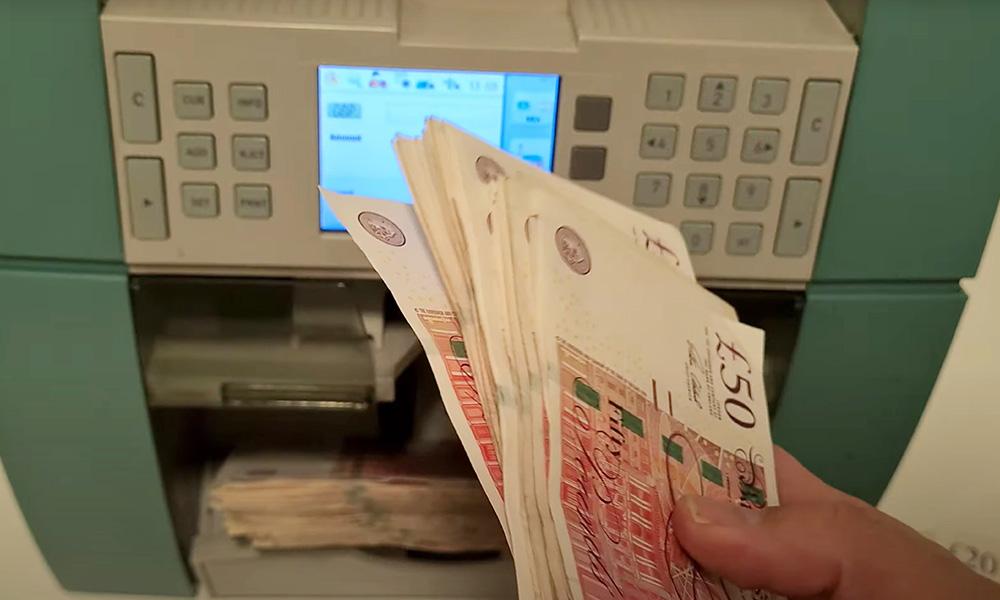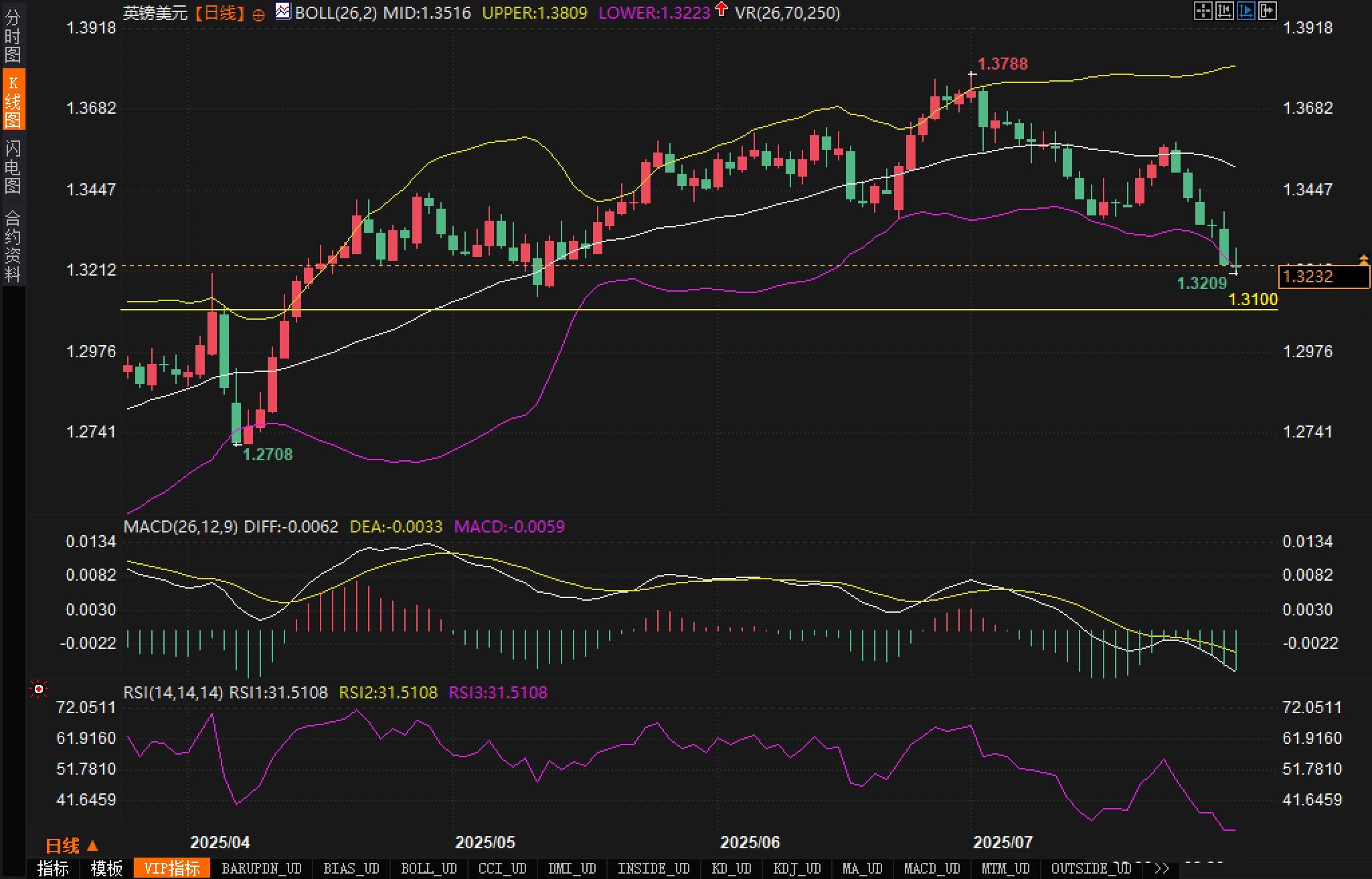The pound's six consecutive declines may confirm a "head and shoulders" pattern. How much room is there for further decline?
2025-07-31 20:29:10

The CME FedWatch tool shows that the market's probability of the Federal Reserve cutting interest rates by 25 basis points in September has dropped from 63.3% on Tuesday to 43.2%. Powell explicitly pointed out that the US economy is currently in a "solid state" and inflation remains "slightly above target", so now is not the time to adjust monetary policy.
US economic data showed second-quarter GDP growth at an annualized rate of 3%, significantly higher than the 2.4% previously expected. ADP employment data showed private sector jobs added by 104,000, also significantly better than the expected 78,000, reinforcing buying momentum for the US dollar. In contrast, the British pound was weighed down by a lull in UK economic data this week, with the market focused on next week's Bank of England (BoE) interest rate decision, with expectations of a possible cut to 4%.
Technical aspects:
The current candlestick chart for the GBP/USD daily chart shows a clear downward trend. The exchange rate has fallen for six consecutive trading days, forming a "six consecutive negative" pattern, reflecting bearish sentiment dominating the market and a lack of effective bullish resistance in the short term.

The price has now fallen below the middle track of the Bollinger Band (1.3516) and is running close to the lower track of the Bollinger Band (1.3223), hitting a low of 1.3209 during the day, just one step away from the key support of 1.3100, and the technical side has further deteriorated.
The 1.3100 level constitutes a medium-term support area. Analysts believe that if the exchange rate falls below this level, it will open up space to fall to the 1.3000 mark or even the previous low of 1.2708; from a morphological perspective, the current market trend constitutes a "head and shoulders top" right shoulder structure starting from the 1.3788 high, and a typical reversal pattern is being confirmed.
The MACD indicator shows that the DIFF line and the DEA line continue to weaken and are below the zero axis, the histogram remains green, and the bearish trend has not eased; the RSI indicator (14 days) is 31.51, close to the oversold range. Although there is room for a technical rebound in the short term, the trend still tends to continue to decline.
Overall, the analysis shows that the GBP/USD is currently in a downward trend, the Bollinger Bands are expanding, the K-line is running close to the lower track, and the technical structure is bearish. If it falls below 1.3100, it may trigger a new round of accelerated decline.
Market sentiment observation:
Judging from the current market performance, GBP bulls are clearly lacking confidence. On the one hand, the lack of UK economic data has left the market lacking fundamental support for the pound; on the other hand, the Federal Reserve's hawkish stance and continued better-than-expected economic data have reinforced the dollar's strength.
The market's expectations for the Bank of England to cut interest rates next week are becoming increasingly strong, with some institutions predicting a 25 basis point cut to 4%, which has put the pound under pressure from "expectations ahead".
Traders are experiencing a typical "risk-off mode shift." While the VIX fear index hasn't seen a significant spike, long positions continue to decline, indicating a decline in market risk appetite. The relative weakness of the British pound and the expected widening of the UK-US interest rate differential are accelerating short-term capital flows into US dollar assets, exerting systemic pressure on the British pound.
At present, the bearish market sentiment for the pound is relatively consistent, and there is a trading tendency of "shorting with the trend" in the market. If there is no sudden good news in the short term, the rebound of the pound may be difficult to sustain.
Market outlook:
Bullish Outlook:
From a short-term perspective, the RSI is approaching oversold territory, suggesting a potential technical rebound. Analysts believe that if support forms at 1.3200, the exchange rate could stage a limited rebound, with a focus on pressure tests at 1.3320 and 1.3440.
If the Bank of England unexpectedly maintains stability or makes a relatively hawkish statement next week, it could also ease selling pressure on the pound, triggering a short-term rebound. At that time, we will focus on the 1.3516 level near the middle Bollinger Band, which serves as a key resistance line for a medium-term reversal.
Bearish Outlook:
Analysts believe that if the pound falls below the important technical support level of 1.3100, it will confirm the formation of a "head and shoulders" pattern, which is expected to open up further downside potential to 1.3000 or even 1.2700. The continued hawkishness of the Federal Reserve's policy path and the continued strong US economic data may keep the dollar strong, further suppressing the pound.
In addition, if the Bank of England sends a clear signal of a rate cut and lowers its growth forecast, the pound may enter a phase of confirming a medium-term bearish trend. The market will re-price the interest rate differential between the UK and the US, which will put a systemic pressure on the exchange rate.
Comprehensive judgment and analysis show that although there is a rebound demand in the short term, the structural short trend has not been broken, and the downside risk in the future market is still dominant. Traders focus on the gains and losses of the 1.3100 line.
- Risk Warning and Disclaimer
- The market involves risk, and trading may not be suitable for all investors. This article is for reference only and does not constitute personal investment advice, nor does it take into account certain users’ specific investment objectives, financial situation, or other needs. Any investment decisions made based on this information are at your own risk.





















